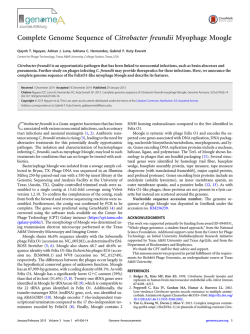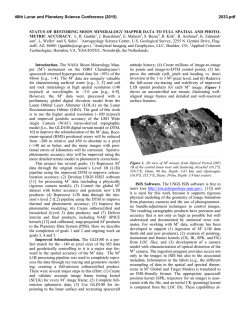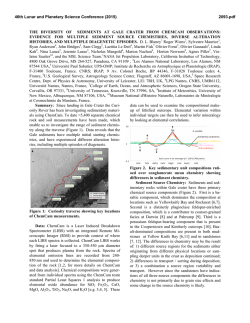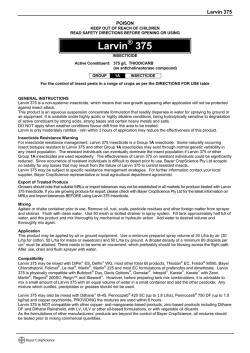
Full PDF
Evolutionary biology rsbl.royalsocietypublishing.org Developmental mode influences diversification in ascidians Max E. Maliska1,2,3, Matthew W. Pennell3,4,5 and Billie J. Swalla1,2,3 1 Department of Biology, University of Washington, 24 Kincaid Hall, Seattle, WA 98195, USA Friday Harbor Laboratories, 620 University Road, Friday Harbor, WA 98250, USA 3 BEACON Center for Evolution in Action, Michigan State University, 1441 Biomedical and Physical Sciences Building, East Lansing, MI 48824, USA 4 Institute for Bioinformatics and Computational Biology (IBEST), University of Idaho, 441B Life Science South, Moscow, ID 83844, USA 5 National Evolutionary Synthesis Center, 2024 W. Main Street, Durham, NC 27705, USA 2 Research Cite this article: Maliska ME, Pennell MW, Swalla BJ. 2013 Developmental mode influences diversification in ascidians. Biol Lett 9: 20130068. http://dx.doi.org/10.1098/rsbl.2013.0068 Received: 23 January 2013 Accepted: 13 March 2013 Subject Areas: developmental biology, evolution, taxonomy and systematics Keywords: speciation, marine invertebrates, binary-state speciation and extinction, larval development Author for correspondence: Max E. Maliska e-mail: [email protected] Electronic supplementary material is available at http://dx.doi.org/10.1098/rsbl.2013.0068 or via http://rsbl.royalsocietypublishing.org. Ascidian species (Tunicata: Ascidiacea) usually have tailed, hatching tadpole larvae. In several lineages, species have evolved larvae that completely lack any tail tissues and are unable to disperse actively. Some tailless species hatch, but some do not hatch before going through metamorphosis. We show here that ascidian species with the highest speciation rates are those with the largest range sizes and tailed hatching larval development. We use methods for examining diversification in binary characters across a posterior distribution of trees, and show that mode of larval development predicts geographical range sizes. Conversely, we find that species with the least dispersive larval development (tailless, non-hatching) have the lowest speciation rates and smallest geographical ranges. Our speciation rate results are contrary to findings from sea urchins and snails examined in the fossil record, and further work is necessary to reconcile these disparate results. 1. Introduction Marine species have evolved modes of larval development that differ in dispersal potential. Thorson asserted that the primary advantage of swimming larvae for sessile or sedentary marine invertebrates is increased dispersal capabilities [1]. However, an alternative hypothesis suggests that planktonic larval development may have evolved in some lineages as an adaptation for escaping from benthic predators [2]. Nevertheless, studies of sister species in divergent metazoan phyla have shown that greater dispersal potential in feeding larvae often positively correlates with higher rates of gene flow between populations [3]. Studies explicitly examining the relationship between larval development and geographical range in extant marine metazoan species have found a positive correlation between larval dispersal potential and geographical range [4,5]. Marine invertebrates species with higher dispersal potential positively correlate with longer species durations and larger geographical ranges [6–9]. Fossil snails and urchins with the derived non-planktonic or less dispersive larval phase show higher speciation rates than planktonic species [6– 10]. In fossil studies, examining the evolution of larval development has often not been done in a phylogenetic framework [6–8], which may overestimate trait effects. Most of the 3000 described ascidians (Tunicata: Ascidiacea) develop as nonfeeding tadpole larvae that swim for a short period (hours to days), then settle and metamorphose into sessile, filter-feeding adults [11]. The Styelidae and Molgulidae show at least five independent origins of tailless larval development [12]. Some tailless species develop indirectly by hatching from the chorion before metamorphosis, and some hatch from the chorion only during metamorphosis (see the electronic supplementary material, tables S1 and S2). & 2013 The Author(s) Published by the Royal Society. All rights reserved. Trees were generated from 1840 bp of 18S rDNA for 45 ingroup taxa of Styelidae and Molgulidae from Genbank and from the phlebobranch outgroup, Ciona intestinalis. Sequences were aligned using MAFFT v. 6 [16]. We used a GTR þ G þ I substitution model selected using the Akaike Information Criterion (AIC; [17]) in MRMODELTEST v. 2.3 [18]. Because ascidians have a scanty fossil record [19], we used an uncorrelated, relaxed-clock phylogenetic estimation in BEAST [20] for 100 million generations. Data on tailed and tailless larval development, and hatching and non-hatching tailless larvae (see the electronic supplementary material, tables S1 and S2) were used to examine how these categorical traits influence speciation rates using a binarystate speciation and extinction (BiSSE) and multi-state speciation and extinction model (MuSSE) [13,14] in the R package diversitree [15]. The BiSSE framework compared models where diversification differed between tailed and tailless larval development, hatching and non-hatching as well as the combination of these characters in the MuSSE framework. AIC [17] was used to test between different models on the consensus tree in BEAST and 100 posterior trees. We compared only speciation rates in the BiSSE and MuSSE analyses because simulation studies have shown extinction rates are difficult to estimate assuming a birth – death model of speciation, and extinction as in BiSSE and MuSSE [21]. The ‘skeletal trees’ incomplete sampling method was used to account for the missing taxa in our tree when estimating rates using BiSSE and MuSSE [14]. Extinction rates were set to be the same rates, given the potential for mis-estimation and parameter correlation. However, it is possible that if extinction rates were widely divergent between species with different larvae, then our model would not be an adequate description of the process, and our inferences may be misled. While we acknowledge this possibility, given how notoriously unreliable estimates of extinction rates are [21], and that estimates derived from molecular phylogenies tend to be very low (often close to 0), we do not think this is a likely scenario. Geographical range sizes were estimated using current species distribution records (see the electronic supplementary material for more information). In brief, we estimated range sizes by removing outlier points, then used a longest straight line distance (rhumbline) or ellipsoidal area. We then tested to see if either binary or additively larval traits were a predictor of geographical range size using Bayesian phylogenetic mixed models in the R package MCMCglmm [22]. The posterior probability of different models were estimated using a MCMC approach, running the chains for 10 million iterations with a one million iteration burn-in. 3. Results All 100 trees show higher speciation rates in tailed species compared with tailless species (figure 1a), and 99/100 trees show higher speciation rates in hatching species compared with non-hatching species (figure 1b). 4. Discussion Our results demonstrate that species with tailed, hatching larval development have higher speciation rates than ascidian species with tailless hatching, and tailless non-hatching larval development (figure 1), based on the available phylogeny (figure 2). Data for 45 of an estimated 762 described species in the Molgulidae and Styelidae were used, but we did use an incomplete sampling method to take this missing data into account [14]. Nevertheless, the small sample of species could bias our results. We also have to be cautious that the phylogeny used for this study may not be the true species tree owing to the coalescent process [23]. However, most clades are reflective of taxonomic and morphological relationships [24], and are in agreement with a phylogeny we inferred on a subset of taxa at 18S and 28S rRNA genes. We accounted for low support for species relationships in our phylogeny by comparing BiSSE and MuSSE analyses across 100 posterior trees. A simulation study examining the ability to detect differences in rates of speciation, extinction and character transitions found there to be a decrease in the ability to detect the true simulated differences using BiSSE when phylogenies were moderately sized [25]. However, low power should tend to reduce our ability to detect differences between parameters, rather than exacerbate them. We have found that when we simulate trees with a 2.5 times difference 2 Biol Lett 9: 20130068 2. Material and methods We tested to see if a combination of our two sets of binary larval traits (tailed and taillessness, hatching and non-hatching) is better for assessing speciation rates using a recently developed test [15]. All 100 trees show a better AIC fit for a model where speciation is estimated as a combination of these binary traits (table 1). 94/100 trees and 100/100 trees show higher speciation rate estimates in the interaction model when compared with speciation rate estimates for tailed and tailless alone, or for hatching and non-hatching alone, respectively. 100/100 posterior trees show the highest speciation rates in tailed hatching species when compared with tailless hatching and tailless non-hatching species. Tailless hatching species show higher speciation rates when compared with tailless non-hatching species in 65/100 posterior trees. Mean rhumbline range sizes for all tailed, hatching species used in the study were 2425+ a standard error (s.e.) of 1201 km. Range sizes were 2164+ s.e. of 1038 km, and 201.4 + 239.9 km for tailless, hatching, and tailless, non-hatching species, respectively (see the electronic supplementary material). For rhumbline range sizes (see the electronic supplementary material, figure S2), we found species with hatching larval development to have larger range sizes than species with nonhatching larval development (b ¼ 2.51 + s.e. 2.12; p ¼ 0.0212). We found similar results for total range sizes comparing species with hatching and non-hatching larvae (b ¼ 5.066 + 2.56; p , 0.001). We found mean range sizes for species with tailed hatching larval development to be the largest, mean range sizes for species with tailless hatching larval development to be intermediate and mean range sizes for species with tailless non-hatching larval development to be the smallest (b ¼ 4.80 + 3.41; p ¼ 0.0067). Results were consistent with analyses on ellipsoid ranges (see the electronic supplementary material for more details). rsbl.royalsocietypublishing.org Likelihood models have been developed recently for examining how discrete characters influence diversification rates inferred from incompletely sampled phylogenies [13 –15]. Using a phylogeny of 45 ascidian species in the Molgulidae and Styelidae, and current distribution records of these species to estimate geographical range sizes, we find that species with less dispersive larval development (tailless non-hatching species) have lower speciation rates and smaller geographical ranges. (a) (b) (c) 3 rsbl.royalsocietypublishing.org 30 40 20 25 15 20 Biol Lett 9: 20130068 posterior probability density 30 15 20 10 10 10 5 5 0 0 0 50 100 150 speciation rate 0 0 100 200 300 speciation rate 0 50 100 150 200 speciation rate Figure 1. Speciation rates (in speciation events per substitution per site) for different larval character states using BiSSE and MuSSE. (a) Speciation rates from BiSSE analyses of tailed and tailless species; (b) speciation rates from BiSSE analyses of hatching and non-hatching species; (c) MuSSE model for species with tailed hatching, tailless hatching and tailless non-hatching larval development. The line below each speciation rate distribution is the 95% credible interval. Species with tailed larvae have a tail and eyespot, tailless species that hatch have a dotted circle and tailless species that do not hatch have a solid circle. Table 1. Model comparison using AIC for BiSSE and MuSSE analyses. The best-fit model from the BEAST consensus tree is in italic, and the numbers of 100 posterior trees that agree with the best-fit model from the consensus tree are given. Td, tailed; Tl, tailless; H, hatching; NH, non-hatching; SI, state independent; SD, state dependent; q, transition. BiSSE Td versus Tl BiSSE H versus NH MuSSE Td 1 H versus Tl 1 H versus Tl 1 NH MuSSE interaction model AIC model AIC model AIC model AIC SD SD-qTl-Td 2212.08 2209.38 SD SD-qNH-H 2223.82 2226.12 SI SD 2174.58 2145.94 SD SD-q21 2183.72 2186.84 SD-qH-NH 2225.58 interaction 2191.26 SD-q31 SD-q32 2188.30 2184.95 SD-q21, q31 2190.43 SD-q21, q32 no. 100 trees 2192.38 54/100 no. 100 trees agree 80/100 no. 100 trees 61/100 agree in speciation rates between the ancestral and the derived state, the power to detect different rates decreases in trees of 23 species (77/100 trees). However, our tree size of 45 tips is enough to detect similar results in large trees (95/100 trees with 45 tips show higher speciation rates in the ancestral no. 100 trees agree 100/100 agree character compared to 98/100 trees with 450 tips; see electronic supplementary materials for more details). We believe that tailed, hatching species cannot evolve from a tailless ancestor because there is molecular evidence to show that pseudogenes are formed in proteins critical for 1 Biol Lett 9: 20130068 1 rsbl.royalsocietypublishing.org 1 4 Molgula citrina 1 0.95 Molgula occulta Molgula bleizi 0.92 Molgula pugetiensis 0.66 Molgula pacifica 1 Molgula oculata Molgula occidentalis 0.97 Eugyra arenosa 1 Bostrichobranchus digonas 0.83 Molgula tectiformis 1 Molgula complanata 0.79 Molgula socialis Molgula retortiformis 1 1 Molgula manhattensis 0.92 Molgula arenata 1 Molgula provisionalis Botryllus schlosseri BS8 A 1 Botryllus schlosseri BS19 E 1 Botryllus schlosseri BS31 D Polyandrocarpa zorritensis 1 Cnemidocarpa humilis 0.8 Pelonaia corrugata 1 Styela plicata 1 Styela montereyensis 0.99 Styela gibbsii Symplegma rubra 0.46 Symplegma reptans 1 1 Symplegma viride 0.64 Botryllus primigenus 0.71 Botrylloides leachi 1 Botrylloides diegensis 0.45 Botryllus planus 0.97Botrylloides violaceus 0.29 Polyandrocarpa tincta 0.39 Polyzoa opuntia 0.96 Metandrocarpa taylori 0.7 Distomus variolosus 1 0.31 Stolonica socialis Cnemidocarpa finmarkiensis 0.65 Polycarpa papillata 0.38 Polycarpa mytiligera 1 Polycarpa aurata 0.75 Polycarpa pomaria 0.99 Dendrodoa grossularia 1 Dendrodoa aggregata 0 2000 4000 6000 8000 10 000 12 000 rhumbline ranges (km) Figure 2. Ultrametric phylogeny of molgulid and styelid ascidians from a consensus BEAST tree. The lower axis bar graph shows range size for each species in km. Species with tailed larvae have a tail and eyespot, tailless species that hatch have a dotted circle and tailless species that do not hatch have a solid circle. swimming in multiple tailless species [26]. It is still unclear, however, why these derived modes of larval development have evolved multiple times (figure 2). Species selection may be acting to maintain tailed, hatching larval development in molgulid and styelid ascidians; this argument was made to explain higher diversification rates in plant species with ancestral self-incompatibile reproduction than in species with derived self-compatible reproduction [27]. Our results showing lower speciation rates in the derived tailless and non-hatching species, which also have significantly smaller geographical ranges, is contrary to the findings of snails and urchins in the fossil record where derived species with smaller geographical ranges have higher speciation rates [6–9]. These contrary results may also be due to unforeseen issues with comparing speciation rates estimated from fossil data and molecular phylogenies. It is also possible that these different results could be due to comparing speciation rates for groups with alternative larval development that are fundamentally different. The transition from feeding to non-feeding larval development in fossil snails and sea urchins may fundamentally affect dispersal and diversification dynamics in different ways than do the loss of the tail and hatching in ascidians. While these transitions to a less dispersive larval mode decrease range sizes in all of the groups compared, range size may not predict speciation dynamics entirely. The findings of lower speciation rates in derived tailless and non-hatching styelid and molgulid ascidian species could also be influenced by the population dynamics of these species with alternative modes of larval development. Some simulation studies support lower speciation rates in species with ecological and geographically patchy distributions [28,29]. Species with non-hatching tailless larval development typically have patchy distributions and are found in very specific locations. For example, Molgula pacifica is found in high wave action ‘blow holes’ [30]. Stanley’s work on burrowing bivalves predicted a lognormal relationship between mean population size and speciation rate [31]. This curve would predict small population sizes at very low speciation rates, and we suggest that this may apply for tailless non-hatching molgulids [31]. This rationale was used to describe species with small average population sizes that are going through a higher rate of extinction than speciation, so ‘many entire species are dying out, then few small populations representing incipient species will be able to blossom into full-fledged species’ [32]. While we are unable to reliably estimate extinction rates using our methods [21], more work will be needed to understand the population dynamics of species with different modes of development in ascidians and other marine invertebrates. We thank the FHL reading group and Richard Strathmann for thoughtful comments on the manuscript, and also thank Luke Harmon and Rich FitzJohn for advice on the Diversitree analyses. M.E.M. was supported by PHS NRSA T32 GM007270 from NIGMS. This material is based in part upon work supported by the National Science Foundation under Cooperative Agreement no. DBI-0939454. References 12. Huber JL, da Silva KB, Bates WR, Swalla BJ. 2000 The evolution of anural larvae in molgulid ascidians. Semin. Cell Dev. Biol. 11, 419 –426. (doi:10.1006/ scdb.2000.0195) 13. Maddison WP, Midford PE, Otto SP. 2007 Estimating a binary character’s effect on speciation and extinction. Syst. Biol. 56, 701–710. (doi:10.1080/ 10635150701607033) 14. FitzJohn RG, Maddison WP, Otto SP. 2009 Estimating trait-dependent speciation and extinction rates from incompletely resolved phylogenies. Syst. Biol. 58, 595 –611. (doi:10.1093/sysbio/syp067) 15. FitzJohn RG. 2012 Diversitree: comparative phylogenetic analyses of diversification in R. Methods Ecol. Evol. 3, 1084–1092. (doi:10.1111/j. 2041-210X.2012.00234.x) 16. Katoh K, Toh H. 2008 Recent developments in the MAFFT multiple sequence alignment program. Brief. Bioinform. 9, 286–298. (doi:10.1093/bib/bbn013) 17. Akaike H. 1974 A new look at the statistical model identification. IEEE Trans. Autom. Control 19, 716– 723. (doi:10.1109/TAC.1974.1100705) 18. Nylander JAA. 2004 MrModeltest v2. Program distributed by the author. Uppsala, Sweden: Evolutionary Biology Centre, Uppsala University. 19. Fedonkin MA, Vickers-Rich P, Swalla BJ, Trusler P, Hall M. 2012 A new metazoan from the Vendian of the White Sea, Russia, with possible affinities to the ascidians. Paleontol. J. 46, 1 –11. (doi:10.1134/ S0031030112010042) 20. Drummond A, Rambaut A. 2007 BEAST: Bayesian evolutionary analysis by sampling trees. BMC Evol. Biol. 7, 214. (doi:10.1186/1471-2148-7-214) 21. Rabosky DL. 2010 Extinction rates should not be estimated from molecular phylogenies. Evolution 64, 1816–1824. (doi:10.1111/j.1558-5646.2009. 00926.x) 22. Hadfield JD. 2010 MCMC methods for multiresponse generalized linear mixed models: the MCMCglmm R Package. J. Stat. Softw. 33, 1–25. 23. Liu L, Yu L, Kubatko L, Pearl DK, Edwards SV. 2009 Coalescent methods for estimating phylogenetic trees. Mol. Phylogenet. Evol. 53, 320– 328. (doi:10. 1016/j.ympev.2009.05.033) 24. Van Name WG. 1945 The North and South American ascidians. Bull. Am. Mus. Nat. Hist. 84, 1–476. 25. Davis MP, Midford PE, Maddison W. 2013 Exploring power and parameter estimation of the BiSSE method for analyzing species diversification. BMC Evol. Biol. 13, 38. (doi:10.1186/1471-2148-13-38) 26. Swalla BJ, Just MA, Pederson EL, Jeffery WR. 1999 A multigene locus containing the manx and bobcat genes is required for development of chordate features in the ascidian tadpole larva. Development 126, 1643– 1653. 27. Goldberg EE, Kohn JR, Lande R, Robertson KA, Smith SA, Igic´ B. 2010 Species selection maintains self-incompatibility. Science 330, 493–495. (doi:10. 1126/science.1194513) 28. Gavrilets S, Vose A. 2005 Dynamic patterns of adaptive radiation. Proc. Natl Acad. Sci. USA 102, 18 040–18 045. (doi:10.1073/pnas.0506330102) 29. Birand A, Vose A, Gavrilets S. 2012 Patterns of species ranges, speciation, and extinction. Am. Nat. 179, 1–21. (doi:10.1086/663202) 30. Young CM, Gowan RF, Dalby J, Pennachetti CA, Gagliardi D. 1988 Distributional consequences of adhesive eggs and anural development in the ascidian Molgula pacifica (Huntsman, 1912). Biol. Bull. 174, 39 –46. (doi:10.2307/1541757) 31. Stanley SM. 1986 Population size, extinction, and speciation: the fission effect in Neogene Bivalvia. Paleobiology 12, 89 –110. 32. Stanley SM. 1979 Macroevolution, pattern and process. San Francisco, CA: W. H. Freeman. Biol Lett 9: 20130068 Thorson G. 1950 Reproductive and larval ecology of marine bottom invertebrates. Biol. Rev. 25, 1 –45. (doi:10.1111/j.1469-185X.1950.tb00585.x) 2. Strathmann RR. 2007 Three functionally distinct kinds of pelagic development. Bull. Mar. Sci. 81, 167–179. 3. Hellberg ME. 2009 Gene flow and isolation among populations of marine animals. Annu. Rev. Ecol. Evol. Syst. 40, 291–310. (doi:10.1146/annurev. ecolsys.110308.120223) 4. Emlet RB. 1995 Developmental mode and species geographic range in regular sea urchins (Echinodermata: Echinoidea). Evolution 49, 476– 489. (doi:10.2307/2410272) 5. Kohn AJ. 2012 Egg size, life history, and tropical marine gastropod biogeography. Am. Malacol. Bull. 30, 163–174. (doi:10.4003/006.030.0115) 6. Hansen TA. 1978 Larval dispersal and species longevity in Lower Tertiary gastropods. Science 199, 885–887. (doi:10.1126/science.199.4331.885) 7. Hansen TA. 1983 Modes of larval development and rates of speciation in Early Tertiary neogastropods. Science 220, 501–502. (doi:10.1126/science.220.4596.501) 8. Jablonski D. 1986 Larval ecology and macroevolution in marine invertebrates. Bull. Mar. Sci. 39, 565– 587. 9. Jeffery CH, Emlet RB. 2003 Macroevolutionary consequences of developmental mode in temnopleurid echinoids from the Tertiary of southern Australia. Evolution 57, 1031–1048. (doi:10.1554/00143820(2003)057[1031:MCODMI]2.0.CO;2) 10. Duda TF, Palumbi SR. 1999 Developmental shifts and species selection in gastropods. Proc. Natl Acad. Sci. USA 96, 10 272–10 277. (doi:10.1073/pnas.96. 18.10272) 11. Shenkar N, Swalla BJ. 2011 Global diversity of Ascidiacea. PLoS ONE 6, 1 –12. (doi:10.1371/journal. pone.0020657) rsbl.royalsocietypublishing.org 1. 5
© Copyright 2025




